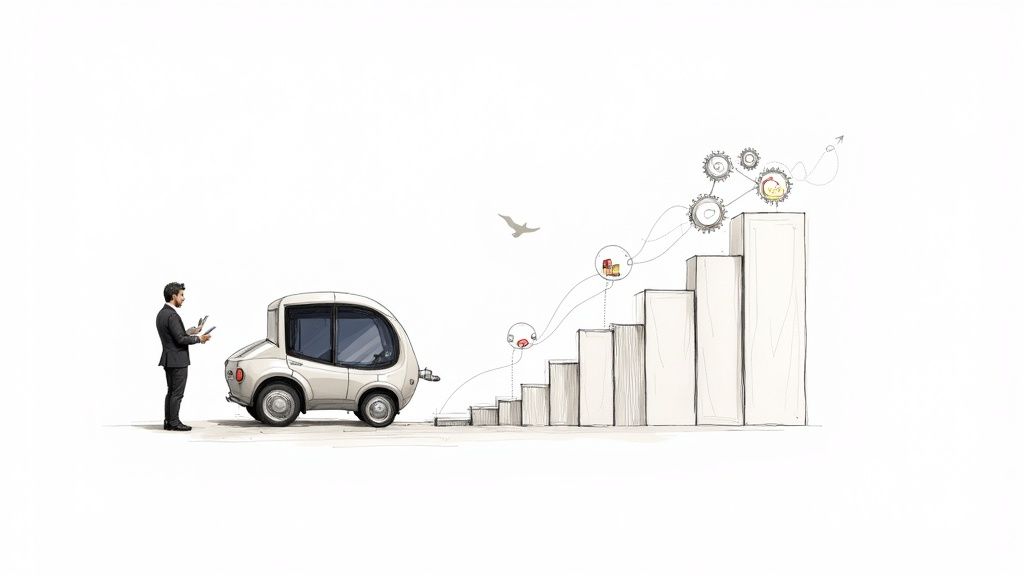For any agency managing Google Ads, marketing automation isn't just about efficiency—it's a strategic necessity. It means leveraging software to handle repetitive, time-consuming tasks so your team can focus on high-impact strategy, creative development, and client relationships. It’s about moving past the daily grind of manual bid changes and endless keyword analysis.
Instead, you start building intelligent, self-optimizing systems within the Google Ads ecosystem that deliver superior results for clients, more efficiently.
The Modern Agency Playbook for Google Ads Automation
The pressure in the PPC world is relentless. Agencies are expected to deliver better ROI while protecting their margins. The old way—manually tweaking campaigns, pulling reports, and sending updates—is slow, prone to human error, and simply can't keep pace with the speed of digital advertising and the sophistication of Google's algorithms.
This is where marketing automation completely changes the game for agencies operating within the Google Ads platform.
Think of it like this: a manually managed Google Ads account is like a standard car. It gets you where you're going, but it requires constant attention—shifting gears, steering, watching the road. An automated account is more like a vehicle with advanced driver-assist. It uses real-time data from the Google Ads auction to navigate the complex ad world, making instant adjustments to bidding and targeting with incredible precision.
Why Automation Is No Longer Optional
Automation isn't just another tool; it's the new operating system for any agency that wants to scale. By implementing smart systems, you unlock significant benefits directly tied to Google Ads performance.
- Elevate Client Results: Leverage machine learning for bid optimization, ad copy testing, and audience targeting far more effectively than a human ever could. This translates directly to better ROAS and lower CPA for your clients.
- Streamline Agency Operations: Free up your team from the tedious work of monitoring budgets, setting up performance alerts, or manually adjusting bids. This gives your PPC experts the time they need to focus on high-impact strategic work.
- Secure a Competitive Advantage: Agencies that master Google Ads automation can manage more clients, deliver superior results, and operate with healthier profit margins. This playbook is your roadmap for weaving marketing automation into your Google Ads services.
For a broader look at how automation can reshape your entire agency and drive major client wins, check out a comprehensive guide to ad agency automation. It’s packed with insights that go way beyond just the Google Ads platform.
Ultimately, this guide is about building powerful, intelligent systems within the Google Ads ecosystem that make your agency more efficient, your clients more successful, and your entire business ready to scale.
Understanding the Core of Google Ads Automation
When agencies hear "Google Ads automation," they often think of Smart Bidding. But that's just one piece of the puzzle. True automation for agencies involves creating a connected system that handles everything from initial keyword bidding to final client reporting.
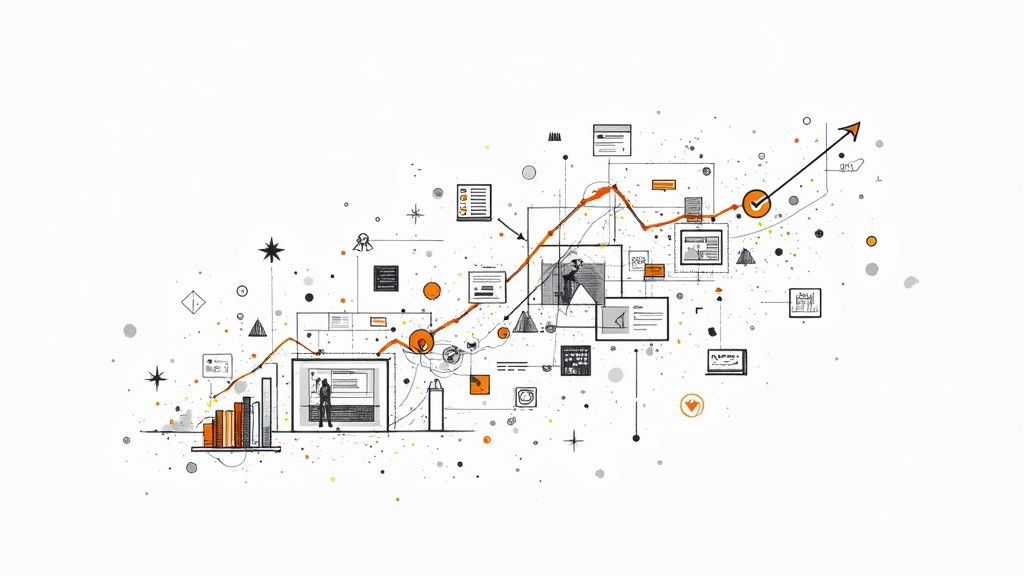
This isn't about handing the keys over to Google's algorithm. It's about designing smart workflows that leverage Google's tools to free up your team's time and drive better, data-backed results. Before diving into specifics, it's useful to understand what workflow automation entails at a high level. It’s about creating processes where software and systems communicate and execute tasks automatically.
For your agency, this translates directly into less time buried in repetitive tasks and more time focused on big-picture campaign strategy and client communication.
The Key Components of Google Ads Automation
To master automation, you need to understand the core components within the Google Ads ecosystem. These are the building blocks for creating an efficient and effective campaign management process.
Here’s what you’ll be using:
- Automated Bidding Strategies: This is the foundation. Instead of manually adjusting CPC bids, you use strategies like Target CPA (tCPA), Target ROAS (tROAS), or Maximize Conversion Value. Google's AI adjusts bids in real-time for each auction to achieve your specific performance goals. For instance, Value-based bidding (VBB), a key focus for Google in 2024, uses conversion values to bid more for users likely to generate higher revenue.
- Custom Google Ads Scripts: Scripts are snippets of JavaScript that automate actions within your account. They can automatically pause low-performing keywords, send alerts for budget pacing issues, or run complex reports, acting as your 24/7 account assistant. A popular script, for example, is the "24-hour Bidding Script," which can adjust bids based on hourly performance data.
- Dynamic Ad Creation: Essential for e-commerce or large inventory clients, features like Dynamic Search Ads (DSA) and Performance Max (PMax) asset groups are lifesavers. They use your website content or a product feed from Google Merchant Center to automatically generate and test thousands of unique ads, matching the most relevant creative to each user's query.
These components work in concert. A script might flag a keyword with a dropping Quality Score, while your tCPA bidding strategy simultaneously lowers the bid on that term due to its poor conversion performance.
Putting Automation into Practice
Let's make this real. Imagine your agency is managing a Google Ads account for a local HVAC company. The old-school approach involves manually checking ad performance daily, adjusting bids for "furnace repair," and constantly writing new ad copy variations.
With automation, the picture changes completely.
An automated workflow using Google Ads Rules could instantly pause any ad group that spends over $50 without a single conversion. At the same time, a Performance Max campaign could be testing dozens of asset combinations (headlines, images, videos) to learn which resonates best with users searching for emergency services.
This shift has a massive impact. Data shows that advertisers who switch from manual CPC to Target CPA bidding see a median 14% increase in conversions. Combining sales and marketing automation can free up an average of five hours per team member each week, allowing them to focus on what really drives client results.
High-Impact Automation Workflows for Your Agency
Knowing the components of Google Ads automation is one thing; applying them is where the value lies. Let's move from theory to action and explore specific, high-impact workflows you can implement right away to save time and improve client results.
Think of these workflows as the operational backbone of a modern Google Ads account. They create a seamless link between campaign management, lead handling, and client reporting, ensuring data flows smoothly and proves your value at every stage.
This image shows how all the pieces can fit together, from lead generation to nurturing and final performance analysis.
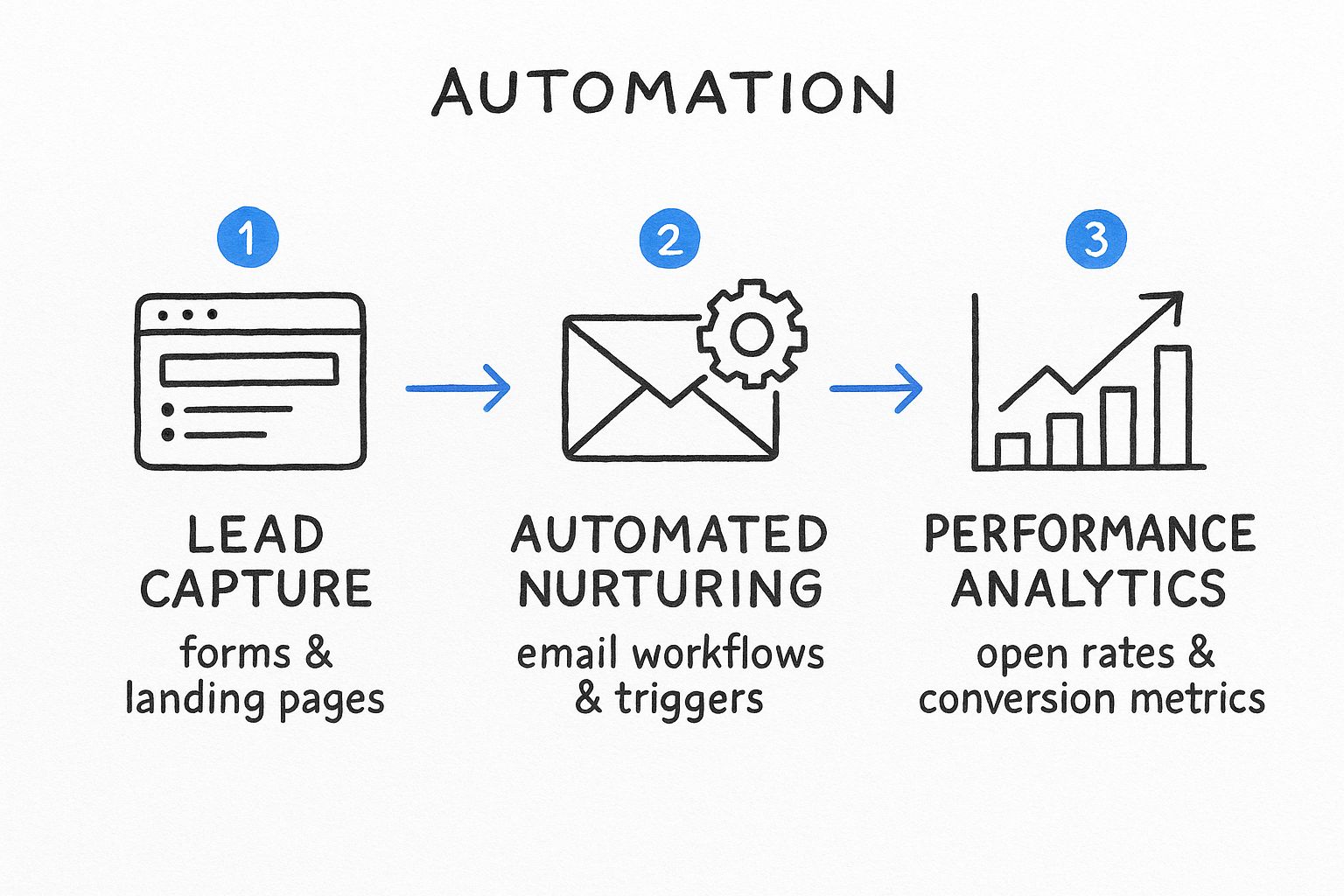
As you can see, this creates a closed loop where every action is tracked and measured, providing clear insights into campaign ROI.
Automated Lead Nurturing for Google Ads Conversions
When a user submits a lead form from one of your client’s Google Ads, speed is critical. An automated lead nurturing sequence ensures immediate and relevant follow-up, which can be the difference between a new customer and a lost opportunity.
Here’s a simple breakdown of how it works:
- The Trigger: A user clicks a Google Ad and submits a lead form extension.
- The Action: Using an integration tool, this instantly triggers a workflow. The lead's data is captured and sent to the client's CRM, often tagged with the specific campaign source (e.g., "Google Ads – Emergency Repair Campaign").
- The Nurture Sequence: A pre-written series of emails is automatically sent. The first might be an immediate "Thanks for your inquiry!" while subsequent emails could offer helpful content or a special offer related to their search.
This simple process ensures every lead from your Google Ads spend receives a prompt, professional response, keeping your client's brand top-of-mind. This is a cornerstone of marketing automation for agencies that directly connects ad spend to lead quality.
Performance-Based Alert Systems
Managing multiple Google Ads accounts means you can't have eyes everywhere at once. A performance-based alert system, built with Google Ads Rules or Scripts, acts as your automated watchdog. It constantly monitors key metrics and notifies you the moment something requires attention.
For example, you could set up rules that automatically send an email or a Slack notification if:
- A campaign's Cost Per Acquisition (CPA) increases by more than 20% week-over-week.
- The Search Impression Share for a key branded campaign drops below 80%, indicating increased competition or budget limitations.
- A specific ad group spends $100 without a single conversion, signaling a potential issue with the landing page or ad relevance.
This type of automation frees your team from manual dashboard checks. Instead of hunting for problems, the problems are delivered directly to them, enabling faster fixes and improved campaign performance.
Automated Client Reporting Workflows
Manually building client reports is a significant time drain for any agency. Automating this process saves countless hours and provides clients with cleaner, more consistent data. Exploring different types of PPC management software for agencies can reveal tools designed specifically for this purpose.
An automated reporting workflow pulls data directly from the Google Ads API into a unified, easy-to-digest format. This could be a live dashboard in a tool like Looker Studio or a branded PDF report that is automatically generated and emailed to your client on the first of every month.
This system guarantees your reports are always accurate and on time, reinforcing your agency's value and fostering a stronger client relationship.
Essential Google Ads Automation Workflows for Agencies
This table highlights valuable automation workflows, the tools needed, and the direct benefits for your agency.
| Workflow | Objective | Required Tools (Examples) | Primary Agency Benefit |
|---|---|---|---|
| Real-Time Bid Adjustments | Automatically adjust bids based on signals like device, time of day, and audience behavior. | Google Ads Smart Bidding, Optmyzr | Frees account managers from manual bid changes; improves ROAS. |
| Budget Pacing Alerts | Get notified if a campaign is on track to over- or under-spend its monthly budget. | Google Ads Scripts, AdStage | Prevents budget waste and ensures campaigns stay on track. |
| Keyword Quality Score Monitoring | Receive alerts when the Quality Score of high-value keywords drops below a set threshold (e.g., 6/10). | Google Ads Scripts, SEMrush | Allows for proactive optimization of ad relevance and landing pages. |
| Negative Keyword Automation | Automatically add irrelevant search terms from a shared negative keyword list to all relevant campaigns. | PPC Protect, Agency-Level Scripts | Saves hours of manual work and improves ad spend efficiency across accounts. |
Implementing even a few of these workflows can dramatically reduce manual effort, allowing your team to focus on high-level strategy and client growth.
Building a Seamless Google Ads Ecosystem
Does your agency's tech stack feel like a collection of disconnected tools? You have Google Ads here, your client's CRM there, and various other platforms in between. This setup leads to manual data entry, information silos, and an incomplete picture of the customer journey, making it difficult to prove the true ROI of your campaigns.
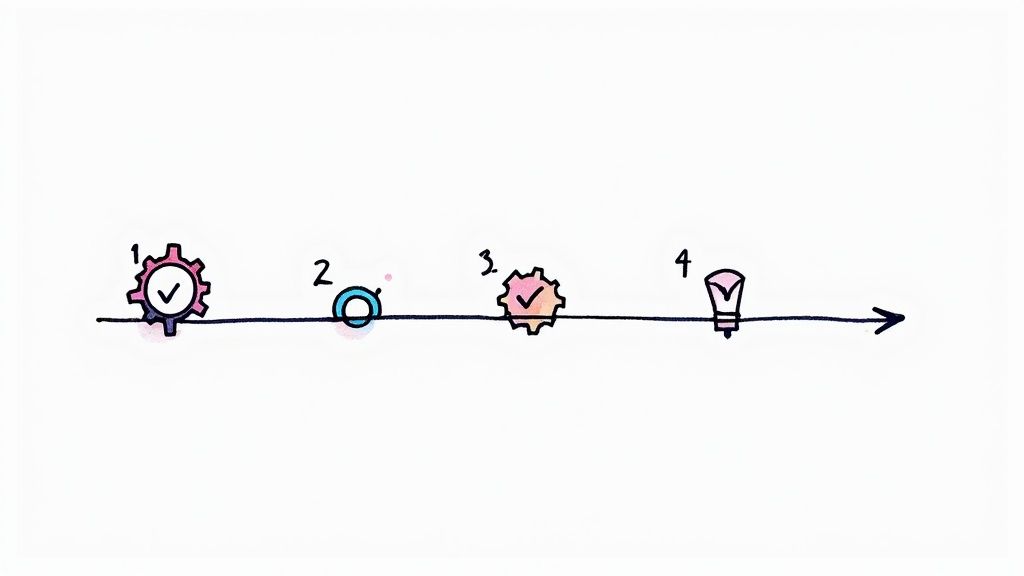
The goal is to build a connected Google Ads automation engine where data flows freely and automatically between platforms. When this happens, isolated actions become part of a coordinated, intelligent strategy.
A connected ecosystem provides a complete, end-to-end view of the customer path, from the initial ad click to the final sale. This is how you demonstrate undeniable value and elevate the conversation beyond basic metrics like clicks and impressions.
The Critical Connection Points
To build this ecosystem, you need to integrate three core parts of your agency's and client's tech stack. These are the pillars of a sophisticated automation strategy.
Here are the key connections you need to nail:
- Google Ads to Your Automation Platform: This is the starting point. A tool like Zapier or Make acts as the central hub, listening for triggers from Google Ads (like a new lead form submission) and initiating a sequence of actions.
- Automation Platform to the CRM: Once a lead is captured, it should be instantly sent to the client’s CRM (like HubSpot or Salesforce), creating a new contact and deal without manual data entry.
- CRM Back to Google Ads: This is the game-changer: closed-loop reporting. By sending CRM data—like when a lead becomes a qualified opportunity or a paying customer—back into Google Ads as an offline conversion, you can optimize campaigns based on actual revenue, not just initial leads. This is essential for Enhanced conversions for leads.
This feedback loop provides a crystal-clear picture of which campaigns, ad groups, and keywords are driving real business results.
Imagine this in action: A new lead from a Google Ad automatically creates a deal in your client's CRM. When the sales team marks that deal as "Won," the conversion value is sent back to Google Ads. The algorithm then uses this data to find more people just like that high-value customer.
The demand for these connected systems is growing. The global marketing automation market was valued at around USD 6.65 billion and is projected to skyrocket to over USD 10.54 billion by 2029. Agencies that can build these ecosystems for clients will have a significant competitive advantage.
Tools That Bridge the Gap
Connecting your different platforms is easier than ever, thanks to a class of tools built specifically for integration.
- Zapier: The most well-known integration tool, Zapier connects thousands of apps with simple "if this, then that" workflows called Zaps. It's user-friendly and ideal for setting up foundational automations.
- Make (Formerly Integromat): For more complex, multi-step workflows, Make offers a powerful visual builder that allows for sophisticated logic and data manipulation between your tools.
- Native Integrations: Always check for built-in connections. Many CRMs and marketing platforms now offer direct, native integrations with Google Ads, which are often the most stable and easiest to set up.
To build a seamless Google Ads ecosystem and streamline agency operations, exploring robust integrations between platforms like GoHighLevel and Humblytics can be a game-changer. By linking these systems, you’re not just automating tasks; you’re creating a powerful, data-driven engine that proves your value and fuels your clients' growth.
Using AI to Take Your Campaign Optimization to the Next Level
While Google's built-in tools like Performance Max and Smart Bidding are powerful, forward-thinking agencies are looking to external AI platforms to gain a competitive edge. These tools work alongside Google's systems to uncover opportunities a human account manager might miss.
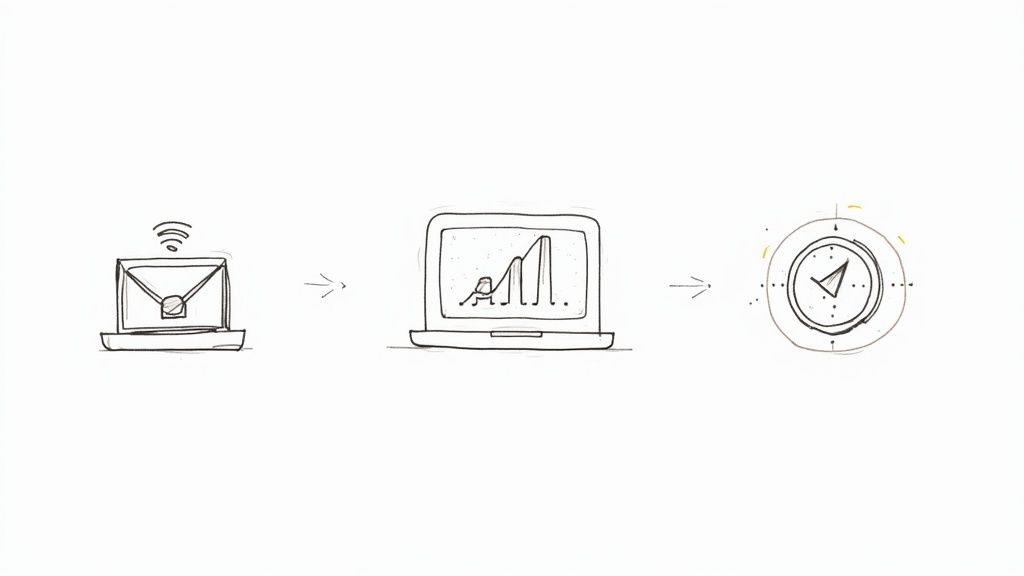
This shifts your team from being reactive to proactive. Think of it as adding a layer of predictive intelligence on top of Google’s own machine learning. You’re not just managing campaigns; you’re anticipating market shifts and user behavior.
This shift is delivering significant results. Companies combining AI with marketing automation see conversion rates jump by an average of 25%. The AI marketing tech market is projected to grow from $20 billion in 2022 to $40 billion by 2025. You can dig into the numbers in these AI marketing projections and their economic impact.
Getting Ahead with Predictive Analytics
One of the key benefits of external AI tools is predictive analytics. They analyze vast amounts of data—historical campaign performance, market trends, competitor activity—to forecast future outcomes with impressive accuracy.
Imagine knowing which campaigns are likely to see a drop in ROAS next month or which keywords are about to become more competitive. This foresight allows you to adjust budgets and strategies before performance dips, making every dollar of your client's ad spend work harder.
Smarter Audience Segmentation
Google's audience tools are powerful, but third-party AI can provide even deeper segmentation. These platforms analyze a client’s CRM data, website behavior, and conversion history to identify subtle patterns that define their most valuable customers.
The real magic is in creating lookalike audiences from these insights. AI can pinpoint new prospects who share hundreds of traits with a client's best customers—signals Google’s algorithm might overlook. This leads to hyper-targeted campaigns that reach the right people with the right message.
This level of detail is a core part of modern marketing automation for agencies. It ensures your client's budget is focused on users who are statistically primed to become loyal, high-value customers.
AI-Powered Creative Optimization
Manually testing ad creative is a slow, laborious process. AI can automate and scale this entire workflow. One of the latest developments from Google is the ability to generate images directly within Performance Max campaigns using generative AI, allowing for rapid testing of unique visuals.
These tools can help you:
- Generate thousands of ad variations, including headlines, descriptions, and now images.
- Automatically test these variations against different audiences and placements.
- Pinpoint the winning combinations of text, images, and calls-to-action in real-time.
This creates a continuous feedback loop where your client’s ads are always evolving based on audience response. You’re no longer guessing which creative will perform best; you have a data-driven system that consistently refines the message for maximum impact.
Common Google Ads Automation Mistakes to Avoid
Automation is a powerful asset, but it's not a silver bullet. When we discuss marketing automation for agencies, we're talking about enhancing your team's capabilities, not replacing their expertise. Many agencies fall into common traps that can harm client accounts.
The biggest mistake is the "set it and forget it" mentality. Automation requires strategic oversight and human supervision. It's a powerful copilot, but you're still flying the plane.
Relying on Smart Bidding with Insufficient Data
Switching to automated bidding is often the first step, but doing so prematurely is a classic error. Algorithms like Target CPA and Target ROAS require a sufficient volume of conversion data to learn and optimize effectively.
If you enable Smart Bidding on a new campaign or one with only a few conversions per month, the system is making decisions in the dark. This leads to volatile performance and wasted ad spend. The solution is to establish a solid data foundation first. A common best practice is to ensure a campaign is generating at least 30-50 conversions over a 30-day period before transitioning to a target-based bidding strategy. Until then, use strategies like Maximize Clicks or Maximize Conversions to gather the necessary data.
Automation without sufficient data is just high-speed guesswork. You must feed the machine with high-quality, accurate conversion data for it to perform effectively.
Forgetting the Human Element in Creativity
Another major oversight is letting automation completely take over creative strategy. While AI can generate and test ad variations at scale, it cannot replicate human empathy, strategic insight, or a deep understanding of a client's brand voice.
Your team’s creativity remains your most valuable asset.
- Strategy First: Automation is a tool to execute the brilliant strategy your team develops, not to create it.
- Ad Copy Nuance: Use AI for brainstorming or A/B testing, but the final, persuasive ad copy requires a human touch to ensure it resonates with the target audience.
- Landing Page Experience: The ad click is just the beginning. A human strategist is essential for designing a landing page experience that builds trust and guides visitors toward conversion.
The winning formula is combining the machine’s efficiency with your team’s strategic and creative intelligence. This partnership delivers campaigns that are not only efficient but also genuinely effective.
Frequently Asked Questions About Google Ads Automation
Embarking on Google Ads automation can feel daunting. Agencies often worry about losing control, the initial setup effort, or how it will change their team's day-to-day responsibilities. Let's address some of the most common questions.
We'll walk through these concerns, providing straightforward answers to help you effectively integrate marketing automation for agencies into your Google Ads management.
How Much Control Will I Lose Over My Campaigns?
This is the biggest misconception. Effective automation is not about relinquishing control; it's about shifting your focus from manual tasks to high-level strategy. You still set the goals, define the budget, approve the creative, and determine the overall campaign direction.
Think of yourself as the architect of the campaign. You create the blueprint and make the critical design decisions. Automation is your expert construction crew, flawlessly executing your vision by handling thousands of micro-tasks like real-time bid adjustments and performance monitoring.
The goal isn't to give up strategic oversight—it's to delegate repetitive work. Good automation gives you more control over the final outcome by freeing up your time to focus on what truly moves the needle.
And you always have the ability to intervene. You can adjust targets, pause a campaign, or launch a new creative test whenever your strategic insight dictates.
Is It Difficult to Set Up Google Ads Automation?
It doesn't have to be. The key is to start small and scale incrementally. You don't need to automate everything on day one. Pick one or two tasks where automation can provide a quick, clear win.
- Start with Smart Bidding: This is an ideal first step. Choose a campaign with a healthy amount of conversion data and switch it to a strategy like Maximize Conversions or Target CPA.
- Set Up Simple Alerts: Use Google Ads Rules to create basic alerts. For example, set up a rule to email you if a campaign’s daily spend exceeds a certain threshold. It’s a simple safety net that takes minutes to implement.
- Automate One Report: Instead of manually pulling data for client reports, connect your account to a tool like Looker Studio. Build one automated dashboard, and you’ll save hours of work every month.
By taking a phased approach, you can build confidence and demonstrate value quickly. Each small success makes it easier to tackle more advanced workflows in the future.
Tired of manually downloading Google Ads leads and sending them to your clients? Pushmylead instantly routes new lead form submissions from your campaigns straight to your inbox, so you can follow up faster and close more deals. See how simple it is at https://www.pushmylead.com.
